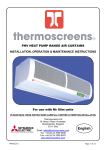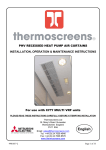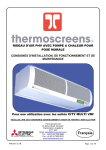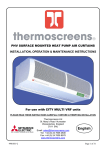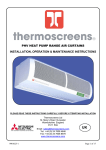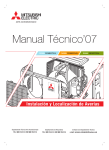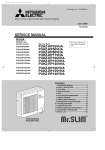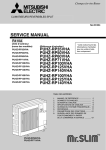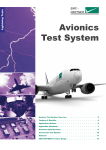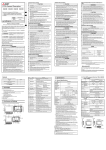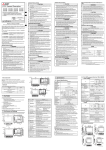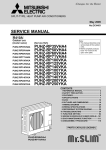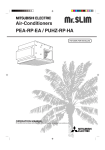Download Mitsubishi PUHZ-RP140VHA Service manual
Transcript
PHVR RECESSED HEAT PUMP RANGE AIR CURTAINS INSTALLATION, OPERATION & MAINTENANCE INSTRUCTIONS For use with Mr Slim units PLEASE READ THESE INSTRUCTIONS CAREFULLY BEFORE ATTEMPTING INSTALLATION Thermoscreens Ltd St. Mary’s Road Nuneaton Warwickshire England CV11 5AU Email: [email protected] Tel: +44 (0) 24 7638 4646 Fax: +44 (0) 24 7638 8578 www.thermoscreens.com 9901030-2 English Page 1 of 23 Thermoscreens / Mitsubishi Electric Heat Pump Warm Air Curtain System Communications Link Manual On/Off Control and Permanent mains electrical supply (from local switched spur) for x Fans x Mitsubishi Electric Interface PCB x Defrost electric heaters (if used) Heat Setting Control Heat Pump Air Curtain Optional BMS Control Interface Board Mitsubishi Electric Outdoor Unit Manual Room Control Procon A32/M The Heat Pump Warm Air Curtain System consists of :• a Thermoscreens 'PHVR Air Curtain' fitted with a PAC-IF010 Mitsubishi Electric Interface PCB • a Mitsubishi Electric 'Mr Slim Outdoor Unit' • a Thermoscreens 'Manual Room Control' for the manual control option by the occupant Refer to Mitsubishi Electric if the air curtain is to be controlled via a Building Management System (BMS) or Centralised Controller. Do not install Manual Room Control and BMS/Centralised Control components together, install either one or the other. A communications link is supplied to the Thermoscreens Heat Pump Air Curtain from the Mitsubishi Electric Outdoor Unit. This link provides control of the heat output of the air curtain and tells the air curtain when the outdoor unit is in defrost mode so auxiliary electric element heaters (if specified) can provide partial heat back-up during the few minutes of defrost. The Air Curtain requires a permanent 3 phase electrical supply (3L+N+E) from a local switched spur to provide power to the defrost cycle electric heating elements, the air curtain fans and the Mitsubishi Electric Interface PCB. If the defrost cycle electric elements are not required they can be permanently disconnected, see 'Electrical Connections', and a 1 phase electrical supply (1L+N+E) used instead. High and Low Output in this document refers to the heat pump heating capacity of the Air Curtain, not to any electrical rating. 9901030-2 Page 2 of 23 UNPACKING THE PHVR HEAT PUMP AIR CURTAIN The following items are supplied and packaged within the air curtain box. PHVR Recessed Heat Pump Air Curtain Manual Room Control Void Filter Air Discharge Air Discharge The Recessed Grille is packed in a separate box but comes with the air curtain:Recessed Grille with Filter If anything is missing or damaged please contact your place of purchase immediately Air Discharge Air Inlet There will also be a “Mr Slim Outdoor Unit” supplied by Mitsubishi Electric. The complete Thermoscreens/Mitsubishi Electric heat pump system, to provide a heat pump warm air curtain over a doorway, including wiring, fridge pipework, etc. is to be installed only by an approved Mitsubishi Electric refrigeration contractor. For your records Date of Purchase…………………………….. Place of Purchase……………………………. Serial Number………………………………… For warranty purposes proof of purchase is necessary so please keep a copy of your invoice. IMPORTANT This Heat Pump Air Curtain in intended only for use with a Mitsubishi Electric Mr Slim Outdoor Unit, for use on R410a with a condensing temperature of 49°C. These instructions must be read in conjunction with the Mitsubishi Electric Mr Slim Outdoor Unit instructions. (All documentation supplied with each unit should be stored and kept for future reference.) 9901030-2 Page 3 of 23 INSTALLATION OF THE HEAT PUMP AIR CURTAIN The air curtain is designed to be recessed within ceiling voids or bulkheads within a building and located horizontally over a doorway. It must not be installed outside of the building. The air curtain is intended for use as a heating only unit. Location The air curtain must be mounted so the recessed grille is between 1.8m minimum and 3.5m maximum above floor level and situated as close to the doorway as possible. The air discharge section of the recessed grille must be nearest to the doorway and the Air Inlet section furthest from the doorway. Beware of doorway top edges, structural beams, door opening/closure devices, etc. which may interfere with the air stream and affect the location of the unit. Air Inlet Air Discharge Air Discharge DOORWAY Ensure there will be adequate clear space above the top of the unit within the ceiling void to safely allow for pipework brazing operations. The PHVR Recessed Heat Pump air curtain has a rectangular air ventilation hole with Void Filter on one side of the unit, see photo of unit on Page 3. This air ventilation hole will be inside the ceiling void once the air curtain is installed and air from the void needs to enter it for the correct operation of the unit. There must be a clearance gap of 80mm minimum between this ventilation hole and any obstruction/bulkhead within the ceiling void to allow ventilation air from the void to easily enter the air curtain. Furthermore, the ceiling void must be sufficiently large and freely ventilated so there will be an adequate supply of ventilation air (m3/hr) to the unit (see table below). If the ceiling void is enclosed around the air curtain it will need an air ventilation grille of effective free area (cm2) as given in the table below and an adequate air path within the void for air to enter the rectangular air ventilation hole. Air Curtain PHV1000R DXE HO Required air flow within Effective free area of ventilation grille ceiling void (m3/hr) for an enclosed ceiling void (cm2) 353 500 PHV1500R DXE LO 421 700 PHV1500R DXE HO 421 700 PHV2000R DXE LO 707 1200 PHV2000R DXE HO 707 1200 9901030-2 Page 4 of 23 Ceiling Suspension Make the cut-out in the ceiling to the dimensions given in Figure 1, overleaf being as accurate as possible. The air curtain can be manoeuvred straight up through the ceiling cut-out. Alternatively the ceiling can be fitted after the air curtain is installed. Bear in mind it will be necessary to carry out pipework brazing operations above the air curtain once it is located in position. Ensure there is sufficient height clearance within the ceiling void to do this. M10 threaded hanging rods Holes are provided in the top face of the casing (see Figure 1 for positions) to allow the unit to be suspended on M10 threaded rods (not provided). All suspension points must be used. Weight (kg) Number of hanging points PHV1000R DXE HO 45 4 PHV1500R DXE LO 66 6 PHV1500R DXE HO 67 6 PHV2000R DXE LO 85 6 PHV2000R DXE HO 88 6 Air Curtain Four of the threaded rods (the two at each end of the unit) enter the casing from above and are attached to fixing brackets near the bottom of the unit (see photo above – looking up into the air curtain). The two centre threaded rods (on PHV1500 and PHV2000 units) are attached to the top face of the casing. Ensure each of the threaded rods is secured onto a suitable structure that can support the weight of the unit (see table above)*. When fitting the threaded rod ensure that it does not interfere with internal components. Threaded rod should engage into fixing holes by a minimum of 20mm and locking nuts fitted to prevent the rod rotating and coming away from its fixing point. Note: When installing the air curtain ensure that the underside of the casing is between 40mm and 65mm above the exposed bottom face of the ceiling tile/plasterboard (see Figure 1). The recessed grille and other air curtain components have adjustment within this range, although aim to achieve the minimum 40mm if possible. *It is the sole responsibility of the installer to ensure that the building fixing points and suspension system used are suitable for the air curtain being installed. 9901030-2 Page 5 of 23 9901030-2 40-65mm CEILING LEVEL Alternative position for Electrical Supply and Control Wiring Inlets Clearance from side of unit for air to enter from ceiling void 1095 2290 800 1690 1655 445 N/A 1190 1155 445 B(mm) C(mm) Cut-Out Length(mm) in Ceiling Width(mm) 55 314 140 A Holes for M10 drop rods 4 for 1m unit, 6 for 1.5m/2m units Use all drop rod holes ! B C Hot Gas Refrigerant Connection B FIGURE 1 – DIMENSIONS OF PHVR RECESSED HEAT PUMP AIR CURTAIN 445 2245 2240 1650 1150 PHV1000R DXE PHV1500R DXE PHV2000R DXE 476 80 296 A(mm) Separator Plate on top of grille 436 Liquid line Refrigerant Connection Electrical Supply and Control Wiring Inlets 100 Page 6 of 23 Fitting the Recessed Grille The recessed grille consists of a frame and grille core with filter attached to it. Fix the four fixing brackets to the grille frame using an M4 screw to fit each fixing bracket. Note which fixing brackets go where (see photo), there are two shapes. Less angled bracket More angled bracket Remove the grille core from the grille frame by unfastening the two conical bolts fitted at each end of the grille core using an 8mm spanner. Then push the grille core sideways against the spring loaded pins on one side and the grille core with filter now comes clear of its frame. Note: The grille core with filter attached will still be tethered to the frame via safety cords and will hang down on these cords. Locate the four M6 bolts that will hold the grille fixing brackets to the air curtain (two inside each end of the unit) and remove these M6 bolts. Lift the frame into position so the air discharge section of the grille will align with the air discharge vanes from the air curtain (see Figure 1 and photos on Page 3). Screw an M6 bolt through the slot in each grille fixing bracket until all four are located in place. Adjust the height of the grille frame (via the slots in the fixing brackets) so the frame fits neatly against the cut-out in the ceiling. Tighten each M6 bolt in place locking the grille frame in the correct position up against the underside of the finished ceiling. The grille core will now be hanging down on its safety cords exposing all the components up inside the air curtain. Within the air curtain there are sliding air separator plates, two on the PHV2000 and one on the PHV1500 and PHV1000. These need to be adjusted up or down to stop the discharge air re-circulating back into the air curtain. Release the M6 bolts at each end of the plate, extend the sliding plate down so it will just touch the topside of the grille along its whole length when the grille core is fitted and tighten the bolts (see photo and Figure 1). It is necessary to temporarily fit the grille core to gauge the required height of the air separator plate(s). Re-fit the grille core by locating each spring loaded pin in its locating hole, push against the spring loaded pins so the fixed pins at the other side of the grille core locate in their fixing holes in the frame. Tighten and secure the conical bolts fitted at each end of the grille core to lock it in position. Note: Access for electrical connections and all servicing is by removing the grille core. Once work on the ceiling is finished remove the protective plastic film from the recessed grille frame. 9901030-2 Page 7 of 23 Mitsubishi Electric Outdoor Unit The Mitsubishi Electric Outdoor Unit is selected to match its refrigerant heat output to the size of the Air Curtain. See table below for size of outdoor unit to be used together with performance data for the air curtain. Heat Output (kW) Air Curtain Mr Slim Outdoor Unit @outdoor air 7/6°C db/wb Full Heat Half Heat Max. Air Volume Flow Rate Max. Noise Level (m3/h) dB(A) @3m PHV1000R DXE HO PUHZ-RP71VHA 8.6 5.34 1400 56 PHV1500R DXE LO PUHZ-RP71VHA 10.1 5.6 2500 58 PHV1500R DXE HO PUHZRP140VKA/YKA 14.4 8.3 2600 58 PHV2000R DXE LO PUHZRP100VKA/YKA 14.1 7.9 3300 59 PHV2000R DXE HO PUHZ-RP200YKA 21.3 11.2 3130 59 Indoor Air Temperature = 20ºC Performance figures derived from independent testing by UK test houses BRE and BSRIA in accordance with test standard EN 14511. The air curtain normally operates under automatic temperature control and can also run at part load. Refrigerant Pipework This must be carried out before connection of any electrical and controls cables and in accordance with the Instructions that come with the Mitsubishi Electric Outdoor Unit. This work must only be undertaken by a Mitsubishi Electric approved Contractor. Refrigerant installation pipework sizes are as follows :Air Curtain Discharge Line (Gas) PHV1000R DXE HO 5 PHV1500R DXE LO 5 PHV1500R DXE HO 5 PHV2000R DXE LO 5 PHV2000R DXE HO Liquid Line in. 3 in. 3 in. 3 in. 3 1 1 in. 3 8 8 8 8 8 8 8 8 8 8 Maximum Pipe Run Length Height in. 50m 30m in. 50m 30m in. 50m 30m in. 50m 30m in. 100m 30m It is intended that refrigerant pipe connections to the air curtain are made using brazed joints and these must be carried out in a professional and safe manner. If installation pipe sizes for the discharge (gas) line and liquid line are different from the pipe connection sizes on the air curtain, suitable pipe reducers must be used for the connection. R410a refrigerant systems can operate at pressures up to 610 psi (c. 42 Bar). These brazed joints may well be located in a public area and a weakness leading to an explosion could be extremely dangerous. The air curtain with its coil is 9901030-2 Page 8 of 23 manufactured in accordance with the Pressure Equipment Directive and the installation must be carried out to a good standard of workmanship. Use a heat sink on the copper pipes when brazing to reduce the transfer of heat to the inside of the air curtain where sensitive components are located. To gain access inside the Air Curtain To gain access for connection of the electrical supply, controls wiring and to work on the unit during commissioning it is necessary to remove the grille core of the recessed grille. Remove the grille core from the grille frame by unfastening the two conical bolts fitted at each end of the grille core using an 8mm spanner. Then push the grille core sideways against the spring loaded pins on one side and the grille core with filter now comes clear of its frame. Note: The grille core with filter attached will still be tethered to the frame via safety cords and will hang down on these cords. Electrical Supply to the Air Curtain This must be carried out AFTER the connection of the refrigerant pipework. All electrical wiring and connections MUST be carried out by a competent qualified electrician in accordance with the latest edition of the IEE wiring regulations and/or local statutory regulations. (see also Wiring Diagram on Page 12) • A local isolator having a contact separation of at least 3mm on all poles must be fitted in the electrical supply to the air curtain and located in an accessible position adjacent to the unit. 1 phase if defrost electric heaters are not required. 3 phase if defrost electric heaters are required. • The appliance must be connected using cables having an appropriate temperature rating (heat resistant). • Ensure that the supply cables, circuit breakers and other electrical installation equipment are correctly sized for the air curtain being installed. See Table overleaf. • A 20mm size cable gland or conduit connector should be used for the Electrical Supply into the air curtain. • This appliance must be Earthed. 9901030-2 Page 9 of 23 Air Curtain PHV1000 DXE HO PHV1500 DXE LO PHV1500 DXE HO PHV2000 DXE LO PHV2000 DXE HO 230V/1ph/50Hz if defrost electric heaters are not used Rated Electrical Rated Current (A) Power Input (kW) 0.3 0.35 0.35 0.5 0.5 400V/3ph/50Hz if defrost electric heaters are required Rated Electrical Rated Current per Power Input (kW) phase (A) 1.3 1.8 1.8 2.7 2.7 4.8 7.8 7.8 9.5 9.5 7.8 12.7 12.7 15.7 15.7 If the defrost electric heaters are to be disabled this can be done by disconnecting the neutral wire (blue or purple) from terminal A2 on the contactor inside the air curtain. The disconnected wire should be terminated safely into unused auxiliary terminal 14NO as shown in the adjacent picture, or into a suitable terminal block (see also wiring diagram on Page 12). Note: If the defrost electric heaters are disconnected, discharge air temperatures could be very cold, approximately 6ºC. Defrost times could also be extended. Wiring to the air curtain should be carried out in accordance with the wiring diagram on Page 12 and IEE Regulations. The figure below shows the completed wiring for a 3 phase electrical supply if the defrost electric heaters are required. 1) Connection from Mitsubishi Electric Outdoor Unit Connections to terminals S2 and S3 provide a communications link between the Mitsubishi Electric Outdoor Unit and the Air Curtain. S1 in the Mitsubishi Electric Outdoor Unit is not used at all for this Air Curtain Indoor Unit. 2) Connecting a 400V/3ph/50Hz supply Connect to terminals L1, L2, L3, N and E with a 3-phase electrical supply. This will power the electric heating elements during the defrost cycle, air curtain fans and the Mitsubishi Electric interface pcb. Connecting a 230V/1ph/50Hz supply Connect to terminals L1, N and E with a 1phase electrical supply. This will power air curtain fans and Mitsubishi Electric interface pcb. NB. Electric heaters must be disabled !! 1 2 3 Alternative entry points 3) Connection from Manual Room Control (required only for manual control) To comply with IEE regulations two separate 2-core, 230v mains rated double insulated cables of different colours should be used to wire from the manual room control. One 2-core cable is wired to terminals 1 & 2 (Heat Setting - signal voltage). The other 2-core cable is wired to terminals 3 & 4 (On/Off switch - 230v). 9901030-2 Page 10 of 23 If a BMS or Centralised Controller is to be used instead of Manual Control it is not necessary to wire to terminals 1-4. NB. Do not install Manual Room Control and BMS/Centralised Control together as they can interfere with each other. Recommended wire size for electrical connections are as follows: 1 1.0mm2 2 2.5mm2 max for access 3 0.75mm2 Do not use cable size of more than 2.5mm2 or connecting the cable is difficult. Electrical details for the Mitsubishi Electric Mr Slim Outdoor Unit are as follows: Mr Slim Outdoor Unit Electrical Supply (V/ph/Hz) Rated Current per phase (A) PUHZ-RP71VHA PUHZ-RP100VHA PUHZ-RP100YHA PUHZ-RP140VHA PUHZ-RP140YHA PUHZ-RP200YHA 230/1/50 230/1/50 415/3/50 230/1/50 415/3/50 415/3/50 19.0 26.5 8.0 28.0 11.0 19.0 9901030-2 Mitsubishi recommended BS88 Fuse Size (A) 20 32 10 32 16 20 Page 11 of 23 9901030-2 K1 1.3A for PHV1000DX 1.8A for PHV1500DX 2.7A for PHV2000DX L2 and L3 are not then needed L1 is then 230V/1ph/50Hz OPTIONAL LOW SPEED CONTROLLER PROCON A32/M 2-core double insulated flex (carries signal voltages) 1 2 A-CONTROL SUB INTERFACE E S1 S2 S3 3 4 Electrical Supply for Outdoor Unit 400V/3ph/50Hz or 230V/1ph/50Hz L1 L2 L3 N SITE WIRING WIRING DIAGRAM – PHVR RECESSED HEAT PUMP AIR CURTAIN K1 1m unit 3 x 1.5kW = 4.5kW 1.5m unit 3 x 2.5kW = 7.5kW 2m unit 3 x 3.0kW = 9kW If Defrost Electric Heating Elements are not required disconnect neutral wire from A2 and terminate wire safely in auxiliary terminal 14NO. Local Electrical Supply for Defrost Electric Heaters and Fans PHV1000 = 7.8A per phase PHV1500 = 12.7A per phase PHV2000 = 15.7A per phase 400V/3ph/50Hz 2-core double insulated flex (carries 230v ac) not used ON/OFF Ambient (Closed) Heat (Open) AUTO Page 12 of 23 COMMISSIONING THE HEAT PUMP AIR CURTAIN Ensure that the electrical supply to both the Mitsubishi Electric Outdoor Unit and the local electrical supply to the Air Curtain are switched off. Air Curtain Checks Check that the components inside the air curtain are as shown in the picture below. Check that the thermal overheat cut-out switch has not ‘tripped’. Push down on the red button on the top of the thermal overheat switch - if it has tripped it will click back on. 3 speed fan switch Air sensor Thermal overheat (located between lower cut-out switch two defrost elements) Set the inner aluminium air vanes within the air curtain air discharge so they point straight downwards over the doorway. Interface PCB Filter Indicator NB. The Mr Slim Outdoor Unit can be test run using dip switch SW4-1 on the outdoor unit (air curtain also needs electrical power) do not run for more than 5 mins as it will operate in cooling. Fixing screw The pcb on its mounting plate can hang freely below the unit. 9901030-2 LED 1 Now go to either “BMS Control” or “Manual Room Control” to continue with the Commissioning of the Air Curtain. DIP SWITCHES For easier withdrawal of the pcb the connection to the filter indicator (shown as * in the right hand figure) may be temporarily removed. * LEDS 2-5 A Mitsubishi Electric Interface PCB is located within the Thermoscreens Air Curtain to provide communication between the Mitsubishi Electric Outdoor Unit and the Air Curtain Indoor Unit. The Interface PCB on its mounting plate is held in place BMS FAN-RUN CONNECTION by a screw located at the lefthand side of the board. Remove the fixing screw and carefully slide the pcb fully out. Page 13 of 23 BMS Control or Centralised Controller On the Mitsubishi Electric Interface PCB check that the BMS Fan-Run Connection is plugged into position CNX1 (as shown on previous page and wiring diagram). The dip switches on the Interface PCB are factory set for BMS Control, check they are as follows: SW1 SW2 ON ON OFF OFF 1 2 3 4 5 6 7 8 SW3 ON OFF 1 2 3 4 5 6 7 8 1 2 3 4 5 6 7 8 Black rectangle indicates moveable head of dip switch Connect a computer running the appropriate software to the Mitsubishi Electric outdoor unit. Switch on electrical power to both the Mitsubishi Electric outdoor unit and the Air Curtain. WARNING! Interface PCB will have 230 volts on it. Communication between the Mitsubishi Electric Outdoor Unit and the Air Curtain commences approximately 30 seconds after power-up. After this time switch on the air curtain using the 'On Off Write' parameter of the BMS software. Once the air curtain fans are operating check that they run at Low (I), Medium (II) and High (III) speeds using the manual 3 speed fan switch inside the left hand end of the air curtain. Check there is no excessive mechanical noise coming from the fans and that all fans are working. Select the fan speed appropriate to the site conditions and leave on this setting. LEDs 1, 2, 3 and 5 on the Interface PCB should be lit. Set the BMS 'Mode' parameter to 2. Provided the return air temperature is below 28ºC the air curtain should now be operating in heating mode. Check that the air stream from the discharge warms up across the whole length of the air curtain after approximately 20 minutes and that the air stream reaches right down across the doorway with the door open or closed. Set up the BMS schedule. It is possible to: • • • • • switch the Air Curtain on and off determine whether the Air Curtain is operating monitor the Return Air Temperature monitor any Mitsubishi Electric system errors read/write the Mitsubishi Electric Outdoor Unit Mode (heating or ambient) Note 1: The 'Mode' parameter should only be set to '2' (heating) or '6' (FanAmbient). The system is designed for heating or Fan-Ambient only, using other 'Mode' settings will result in incorrect operation or malfunction. Never set the 'Mode' parameter to '1' (cooling) as the air curtain is not designed to cope with condensate. Note 2: The set point and fan speed of the air curtain cannot be altered through the BMS or Centralised Controller. The set point is hard coded to 28ºC * via dip switch SW2 on the Mitsubishi Interface PCB in the air curtain. The fan speed is set manually at commissioning using the 3 speed fan switch inside the air curtain (see above). * for Set Point 26°C use dip switch settings SW2-3 ON, SW2-4 OFF, SW2-5 ON * for Set Point 24°C use dip switch settings SW2-3 OFF, SW2-4 OFF, SW2-5 ON Switch off the electrical power to the Mitsubishi Electric Outdoor Unit and Air Curtain. Carefully slide the Interface PCB back into place, replacing the Filter Indication connection if removed earlier. Ensure cables are not trapped inside and refit retaining screw. The Filter Indicator Schedule can now be changed from its default setting if 9901030-2 Page 14 of 23 required (see page 17). Refit the recessed grille core with air filter (see “To gain access inside the Air Curtain” page 9). Power-up both the Mitsubishi Electric Outdoor Unit and Air Curtain and re-check the operation of the unit. Manual Room Control On the Mitsubishi Electric Interface PCB the BMS Fan-Run Connection should be 'parked' at position CNX5 (green), see Wiring Diagram – Page 12. The dip switch settings should be as follows: SW1 SW2 ON SW3 ON OFF ON OFF 1 2 3 4 5 6 7 8 OFF 1 2 3 4 5 6 7 8 1 2 3 4 5 6 7 8 Black rectangle indicates moveable head of dip switch On the Thermoscreens Manual Room Control set the Fan On/Off switch to Off '0' and the Ambient/Heat switch to Ambient ' ' Fan only. Switch on the electrical power to the Mitsubishi Electric outdoor unit and the Air Curtain. WARNING! Interface PCB will have 230 volts on it. Room Control Heat setting switch • automatic • full heat • half heat Fan On/Off switch I 0 Ambient/Heat switch Communication between the Mitsubishi Electric Outdoor Unit and the Air Curtain commences approximately 30 seconds after power-up. After this time use the Room Control to switch on the fans. Once the air curtain fans are operating check that they run at Low (I), Medium (II) and High (III) speeds using the manual 3 speed fan switch inside the left hand end of the air curtain. Check there is no mechanical noise coming from the fans and that all fans are working. Select the fan speed appropriate to the site conditions and leave on this setting. Using the Manual Room Control set the Ambient/Heat switch to Heat ' ' and the heat setting switch to Full Heat ' '. Check that the air stream from the discharge warms up across the whole length of the air curtain after approximately 20 minutes and that the air stream reaches right down across the doorway with the door open or closed. Use the Manual Room Control to test the different heat settings. LEDs 1-5 on the Interface PCB should be lit as follows. • LED 1 indicates that there is power to the air curtain • LEDS 2-5 indicate the different heating settings selected via the Manual Room Control heat setting switch 9901030-2 Heat setting ambient half heat full heat automatic LEDs lit 1 1,3 1,3,5 1,2,3,5 Page 15 of 23 Note 1: The set point and fan speed of the air curtain cannot be altered through the Manual Room Control. The set point is hard coded to 28ºC * via dip switch SW2 on the Mitsubishi Interface PCB in the air curtain. The fan speed is set manually at commissioning using the 3 speed fan switch inside the air curtain, as described above. * for Set Point 26°C use dip switch settings SW2-3 ON, SW2-4 OFF, SW2-5 ON * for Set Point 24°C use dip switch settings SW2-3 OFF, SW2-4 OFF, SW2-5 ON Switch off the electrical power to the Mitsubishi Electric Outdoor Unit and Air Curtain. Carefully slide the Interface PCB back into place, replacing the Filter Indication connection if removed earlier. Ensure cables are not trapped inside and refit retaining screw. The Filter Indicator Schedule can now be changed from its default setting if required (see page 17). Refit the recessed grille core with air filter (see “To gain access inside the Air Curtain” page 9). Power-up both the Mitsubishi Electric Outdoor Unit and Air Curtain and re-check the operation of the unit via the Manual Room Control. Filter Dirty Indicator The air curtain is fitted with a Filter Dirty Indicator. It is located at the left-hand end of the air discharge grille and signals when the air curtain inlet grille filters should be vacuum cleaned or the air curtain requires servicing. The indicator states are outlined below: Indicator State Indicator Light Action Required Reset Button GREEN FLASH RED ON RED FLASH On 0.5s; Off 3s On permanently On 0.5s; Off 0.5s None Vacuum inlet Service filters N/A Quick reset Press for 5s START 120 hrs RED ON: Quick reset 120 hrs 480 hrs Fan operating hours The filter indicator schedule is based on fan operating hours. For the default schedule, shown schematically below, the inlet grille filter should be vacuum cleaned every 120hrs of fan operation (every 1 to 2 weeks) and a full service should take place every 480hrs of fan operation. RED ON: Quick reset 120 hrs RED ON: Quick reset 120 hrs RED FLASH: Hold 5s to reset The factory set default schedule is suitable for most applications. However, the actual frequency of cleaning required will depend on the environment. Two alternative filter 9901030-2 Page 16 of 23 indicator schedules are available, and can be selected by changing the ‘jumper’ position (marked 1, 2 or 3) on the Filter Indicator pcb. Filter Indicator Schedule Jumper position Doublefrequency Default Halffrequency • • • • • • • • • • • • 1 23 1 23 1 23 Inlet grille vacuum interval 60 hrs 120 hrs 240 hrs Filter service interval 240 hrs 480 hrs 960 hrs To access the Filter Indicator pcb to change jumper position :- Switch off the electrical power to the Heat Pump Air Curtain. Remove the recessed grille core from the air curtain (see To gain access inside the Air Curtain, Page 9). Unfasten the two screws as indicated. The Filter Indicator pcb is now accessible to change the jumper position. Fixing screws Jumper Once the filter indicator pcb ‘jumper’ has been re-positioned, re-fit the filter indicator and replace the recessed grille core. Hand-over to End-User Before leaving site it is important that there is a 'Hand-Over Meeting' to hand-over the heat pump system and air curtain installation to the end user or their representative. This should include a full and clear explanation of how the system operates and a demonstration showing the air curtain running. Be sure to explain the Filter Indicator Schedule, that the air inlet grille must be regularly vacuum cleaned and the unit serviced at regular intervals. If the air curtain is to be operated under manual control, it is important that the end user understands how the Thermoscreens Manual Room Control operates (see Page 15). That the air curtain operates in FAN (Ambient) mode or in HEAT mode with a fixed target temperature of 28°C, or less if the hard coded set point has been changed via dip switch SW2 on the Mitsubishi Interface PCB in the air curtain (see Page 14). If the air curtain is to be operated under the control of a BMS System or Centralised Controller, explain all the settings and demonstrate the operation of the system. That the air curtain should be operated in FAN (Ambient) mode or in HEAT mode with a fixed target temperature of 28°C, or less if the hard coded set point has been changed via dip 9901030-2 Page 17 of 23 switch SW2 on the Mitsubishi Interface PCB in the air curtain (see Page 14). It is vital they understand that the air curtain must not be run in COOL or AUTO mode. Ensure that all instructions and manuals are handed to the end user or their representative. 9901030-2 Page 18 of 23 SERVICING THE HEAT PUMP AIR CURTAIN Vacuum Clean the Air Inlet Grilles / Filters (Weekly, or when the Filter Dirty Indicator shows PERMANENT RED) With the air curtain switched OFF, a vacuum cleaner with an extension tube and brush attachment at its end should be used to clean the face of the air inlet grille and the filter at the back of the grille. This is important to minimise the build-up of dust and lint on the air filter which will affect the performance of the air curtain. This is a simple service task that can be carried out by the Cleaner or Janitor on a weekly basis from floor level without having to access the air curtain at high level. This should be done weekly as a regular service task and/or when the Filter Dirty Indicator shows permanent red. Reset the Filter Dirty Indicator after cleaning by a quick press of the Reset Button (even if the indicator has not gone red). Servicing the Air Curtain (suggest every 3 Months, or if the Filter Dirty Indicator shows FLASHING RED) Always disconnect and isolate the mains electricity supply both at the local electrical supply to the Air Curtain and at the Mitsubishi Electric Outdoor Unit before servicing, maintaining or repairing the Air Curtain. Note: All servicing, maintenance and repairs to the air curtain must be carried out by an approved Service Agent. Towards the rear of the recessed grille (nearest the doorway), and at each end of the grille, there are two conical bolts that prevent the grille being removed without the use of tools. Loosen these two conical bolts using an 8mm spanner. Then push the grille core towards the doorway against spring loaded pins on one side and the grille core with filter now comes clear of its frame. Note: The grille core with filter attached will still be tethered to the frame via safety cords and will hang down on these cords. 9901030-2 Page 19 of 23 The grille filter can now be unclipped from the grille and brushed and vacuum cleaned. Looking up inside at the front edge of the unit (the edge furthest from the doorway) there are 2 or 3 screws inset into the frame (see photo). Loosen each of these screws by 2 turns. Reach up and pull the metal retaining strip over to one side and remove the retaining strip. Pull the void filter outwards at the bottom and then remove from the air curtain. It can then be brushed and vacuum cleaned. Refit the filters opposite to removal. The filters are very durable but may need to be replaced after a number of service intervals. Vacuum clean and remove any build-up of dust, dirt and debris within the air-curtain, especially on the face of the coil and the electric heating elements. Note: Fan motors are permanently lubricated and require no additional lubrication. Once the air curtain has been cleaned, visually inspect the air curtain components. Ensure pipe temperature sensors are located in their pockets and any foam insulation covering these pockets is un-damaged. Check the location of the thermal overheat cutout and air sensor and that the thermal overheat cut-out switch has not tripped (see Section – Commissioning, Page 13). Check all electrical connections and terminals within the unit are tight and that crimp connections have not become loose. After all the components have been re-fitted switch on the electrical supplies and fully function test the air curtain to ensure correct operation (see Section – Commissioning, Page 13). Reset the Filter Dirty Indicator after the service by pressing the Reset Button for at least 5 seconds (even if the indicator has not gone flashing red).and hand back the unit to the end user. 9901030-2 Page 20 of 23 Fault Conditions If the Thermoscreens Heat Pump Warm Air Curtain System does not operate as expected refer to the fault finding table below: Symptom Possible Cause Electrical power is not switched on at both the Mitsubishi Electric Outdoor Unit and at the local electrical isolator next to the Thermoscreens Air Curtain Air curtain does not operate BMS Control: Air curtain is set to 'Off'. Manual Control: Manual Room Control, Fan On/Off switch set to Off '0' Problem with air curtain fan motor(s), or internal wiring, or controls Action Required Switch on power to Mitsubishi Electric Outdoor Unit and Thermoscreens Air Curtain and wait for 30 seconds Check BMS schedule and amend if necessary Use Manual Room Control to adjust fan and heat settings as appropriate Use wiring diagram to investigate possible cause of fault Give system sufficient time to reach operating condition Check BMS schedule and change to HEAT if necessary Use Room Control to adjust fan and heat settings as appropriate If necessary adjust the fixed target temperature via dip switch SW2 (see Page 14) Air curtain has been running for less than 20 minutes and is still warming up BMS Control: Air curtain is set to FAN (Ambient) Manual Control: Manual Room Control, Ambient/Heat switch is set to FAN (Ambient) ' ' Air curtain is Fixed Target Temperature on dip switch discharging SW2 on Mitsubishi interface pcb in air cold air curtain is set too low for heating Manual Control: Heat setting switch on Manual Room Control is set to 'AUTO' NB. Air Curtain will only heat if room air temperature is below and the SW2 fixed target temperature the target temperature. has been exceeded Service air curtain as Air Curtain filters and/or heating coil is described in Section – dirty. Servicing on pages 19 & 20 Mitsubishi Refer to Mitsubishi Electric Electric A variety of error codes can occur Service Manual to understand system is because of a fault within the air curtain fault, then inspect and repair indicating an air curtain if there is a fault error code If the Heat Pump Warm Air Curtain System is still not operating correctly call for a Mitsubishi Electric Service Agent. 9901030-2 Page 21 of 23 Warranty If any problems are encountered with the heat pump warm air curtain please contact your Mitsubishi Electric Service Agent. Care has been taken in compiling these instructions to ensure they are correct, although Thermoscreens Ltd. disclaims all liability for damage resulting from any inaccuracies and/or deficiencies in this documentation. Thermoscreens Ltd. retain the right to change the specifications stated in these instructions. Thermoscreens Ltd St. Mary’s Road Nuneaton Warwickshire England CV11 5AU Email: [email protected] Tel: + 44 (0) 24 7638 4646 Fax: + 44 (0) 24 7638 8578 www.thermoscreens.com 9901030-2 Page 22 of 23 Thermoscreens Ltd St. Mary’s Road Nuneaton Warwickshire CV11 5AU United Kingdom Telephone: +44 (0)24 7638 4646 Fax: +44 (0)24 7638 8578 EC DECLARATION OF CONFORMITY as defined by the EC Council Directive on Machinery 2006/42/EC, the Low Voltage Directive 73/23/EEC, the Electromagnetic Compatibility Directive 89/336/EEC and the Pressure Equipment Directive 97/23/EC Herewith we declare that the air movement equipment designated below, on the basis of its design and construction in the form brought onto the market by us in accordance with the relevant safety, health and performance requirements of the Machinery. If alterations are made to the machinery without prior written permission from us this declaration becomes invalid. Designation of Equipment : THERMOSCREENS AIR CURTAINS Series Type : PHV1000 DXE HO, PHV1000RDXE HO, PHV1500 DXE LO, PHV1500RDXE LO, PHV1500 DXE HO, PHV1500R DXE HO, PHV2000 DXE LO, PHV2000R DXE LO, PHV2000 DXE HO, PHV2000R DXE HO Relevant EC Council the Machinery Directive (2006/42/EC) the Low Voltage Directive (73/23/EEC as amended by 93/68/EEC) the Electromagnetic Compatibility Directive (89/336/EEC as amended by 91/31/EEC and 93/68/EEC) the Pressure Equipment Directive (97/23/EC) Applied Harmonised Standards : Machinery - EN 292-1, EN 292-2, EN 294, EN 394, EN 414 LVD - EN 60335-1, EN 60335-2-30, EN 60335-2-40 EMC - EN55011, EN 61000-3-2, EN 61000-3-3, EN 61000-4-2, EN 61000-4-4, EN61000-4-5, EN61000-4-11, EN61000-6-4 PED - EN 13134, EN 13133 Basis of Self Attestation : Quality Assurance to BS EN ISO 9001 : 2000 B.S.I. Registered Firm Certificate Number FM 85224 Responsible Person : Mr. M. Francis, Managing Director, Thermoscreens Limited Date : 17th June 2009 Signed : 9901030-2 Page 23 of 23























